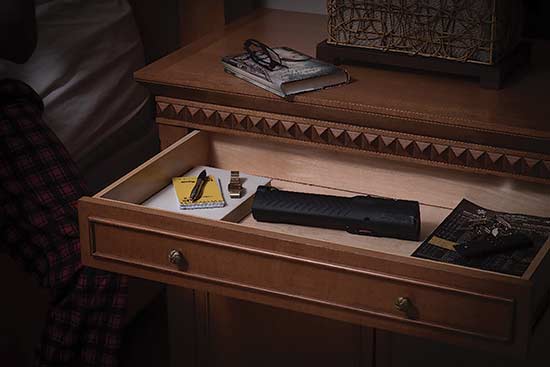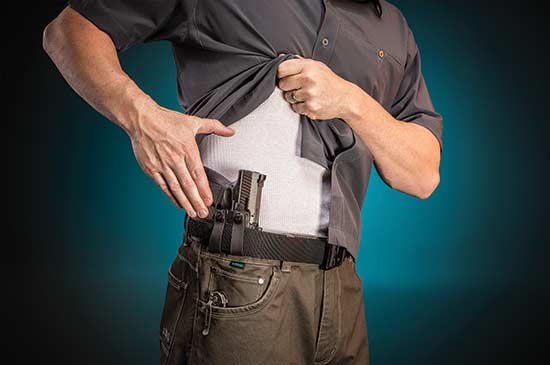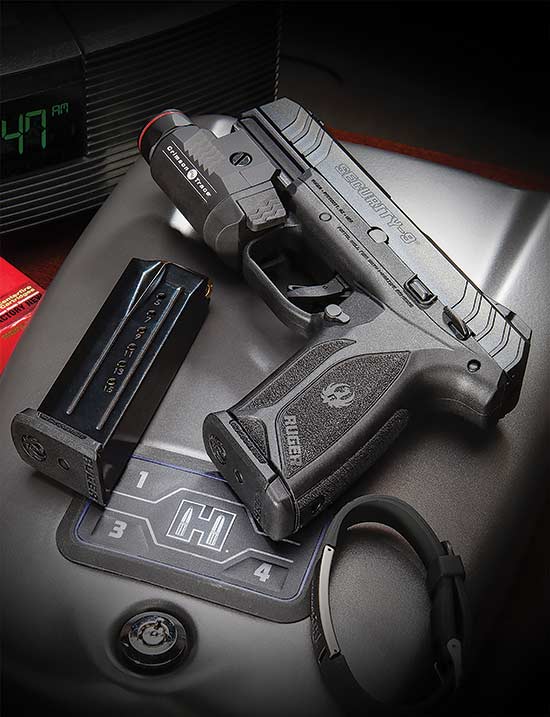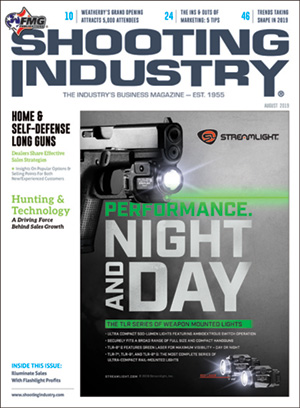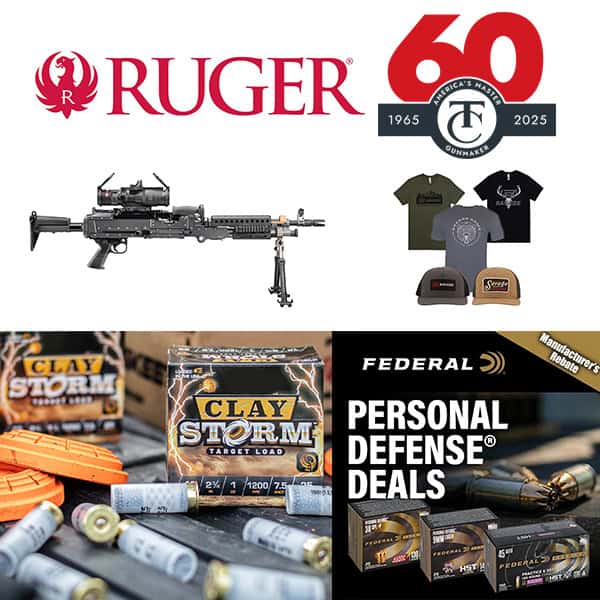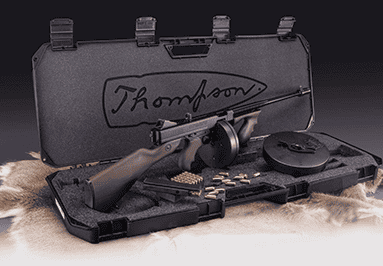5 Tactics
For Improving Self-Defense & Concealed Carry Sales
In the last decade, we’ve seen a massive increase in consumer interest in self-defense, generally, and concealed carry, specifically. The forward progress in these markets — undergirded by Supreme Court decisions, numerous state laws and a populace growing in its desire to defend itself — has been significant, if not revolutionary. In fact, through the first six months of 2018 NSSF-adjusted NICS background checks remained fairly balanced compared to 2017 (6,594,615 compared to 6,809,784 through Jan.–June 2017, down 3.2 percent). Of course, not all of those checks were for concealed carry guns (which represents just one portion of the overall self-defense market), but many were. And it’s just one data point demonstrating a healthy market segment.
While there’s some truth in existing as a dealer or store in this segment can result in some success, there’s more truth found in working hard to keep customer attention for steady and increasing sales. As such, here are five tactics to improve self-defense and concealed carry sales.
1. Use Both Hard-Sell And Soft-Sell Tactics To Inform And Persuade Potential Customers
Will Ceron is co-owner of Check 6 Arms, a dealer in the Northwest Denver metro area. Though his store offers a wide range of guns and gear for sale, he’s taken both a hard- and soft-sell approach to engaging new customers in the self-defense/concealed carry market.
Throughout the year, Check 6 Arms partners with Broomfield, Colo.-based Colorado Krav Maga (COKM), who regularly conducts a Concealed Handgun Fundamentals course as well as a two-day live-fire course. The Check 6 Arms staff sets up a table at the COKM training locations with some popular carry pistols for students to handle and inquire about.
According to Ceron, “Many of the students are new to the concealed carry world and use loaner pistols for the course. After they complete the course, they’re excited and ready to buy. So we show them some of the popular carry guns and offer them a discount to entice them to buy from us.”
Ceron points out Check 6 Arms doesn’t sell firearms at the COKM courses; anyone interested in a purchase still has to come to the Check 6 Arms store to purchase. He says this represents their hard sell.
“The soft sell is to post videos on our social media sites showing actual footage of self-defense uses with a firearm. The video gets shared and spread around, which leads to more people coming back to our page and clicking on our website link,” Ceron said. In May 2018, one Check 6 Arms video received 11,400 organic views with 4,100 engagements.
(Editor’s Note: Last month’s issue touched on how the “unboxing” phenomenon is being used to spark intrigue from customers. Visit this link to see how you can incorporate it in-store: www.shootingindustry.com/reviews-rule-our-decision-making.)
2. Be Aware Of The Most Popular Self-Defense And Concealed Carry Products
You need to know more about market segments other than mere sales activity and trends. Getting into the details of sales data will prove eminently helpful in planning your store’s future buys. Self-defense and concealed carry as a segment is very broad. Inside of it consists numerous kinds of gear — holsters, belts, handguns, ammunition, lasers, knives, everyday carry stuff and more — with varying sales trends and opportunities for thoughtful, well-timed promotions.
Gun belts (because the vast majority of them are incredibly durable and versatile) may be a one-time purchase for most of your customers, whereas ammunition could be a purchase made every time a customer stops by. Frequent purchases are great, sure, but do your part to thoughtfully inform customers about why they should purchase from you. Maybe make it a theme of your store to encourage customers to buy a box of ammo every time they visit — spreading the cost out over time. Or, while your customers may only buy one knife or one gun in a year’s time, remind them those products need to be cleaned and sharpened.
Holsters are another matter. Most handgun owners have the proverbial shoebox full of holsters — each with a story about how it was necessary at one point to have but then, as needs changed, was no longer required. Many have multiple uses for their handguns and legitimate needs for multiple holsters. Being able to talk through these things with your customers will help them see you as a source of insight, increasing the opportunity for a sale. (As an aside: In the July issue, Jason Gentz of Arnzen Arms shared, “Profit margins are almost double once you add in a holster and a magazine” to a firearm sale.)
Ceron says Check 6 Arms gets many requests for the BLACKHAWK! SERPA holsters because of the gun retention feature.
“Students in the COKM firearms courses end up crawling, rolling, running, jumping, fighting, etc. and need a holster that will hold the gun securely,” he lends.
Additionally, customers will sometimes ask which particular guns or gear sell best, relying on this data to develop their own opinion. Be able to share this information with them along with the reasons why it is so. But also be able to provide a customer with some insight and advice on when they shouldn’t follow the crowd.
According to Ceron, the two top selling pistols at Check 6 Arms are the GLOCK 43 and GLOCK 19 with the S&W Shield coming in third. As for self-defense ammunition, Hornady Critical Defense leads the way at the store.
3. Understand What Information Or Sales Approach Moves Consumers To Purchase
With self-defense and concealed carry, the more specific you can be with a customer, the better it will go for their decision-making process and for you. Show a customer a gun-in-holster combination (unloaded and safe, of course), installed on your person or a staff member who’s a similar size and shape. Consider letting customers try some carry rigs on themselves. “Specific firearms with examples of concealability gets them interested,” Ceron said.
Then, Check 6 Arms staff will follow up with questions designed to get the customer to recall a personal situation where they wish they had a firearm on their person. Or they bring up scenarios the customer hasn’t considered where having a concealed weapon would be prudent.
“We don’t like to use scare tactics,” says Ceron. “But we do lean on a matter-of-fact type of approach to engage their logical thinking over emotional thinking. A decision based on logic is the best way to justify a purchase.”
4. Gauge Your Customers’ Propensity For Lethal vs. Non-Lethal Tactics Or Gear
Often, self-defense minded customers grow into the idea of carrying of a concealed handgun for self-defense. They’ll start with a knife, pepper spray or a tactical pen, or with self-defense training in martial arts, and then realize they need to be prepared for more. It can work in reverse, too, with those who carry a concealed handgun adding lesser-lethal types of gear. It’s less likely they’ll replace a gun with something else. In any case, do what you can to learn where your customers are on the spectrum of self-defense and what their real-life situations look like. Then you can intelligently advise them, either way, on how to improve on their carry gear.
5. Value The Relationship In The Sales Cycle Between Customer Training And Purchasing
Consider whether you see customer self-defense training informing their purchase or whether their purchase creates an opportunity to sell training. If you’re not offering any kind of training for customers, find a trusted organization you can recommend to help them.
According to Ceron, “We refer people to COKM. We have a good relationship with them and can, without hesitation, recommend their comprehensive, no-nonsense training for both hands-on and firearms training.”
Training and purchasing can run a constant cycle over years, with both organizations benefiting not just the customer, but each other.
Mark Kakkuri is a freelance writer covering guns, gear and the business of the firearms industry.
You can follow him on Twitter @markkakkuri.

